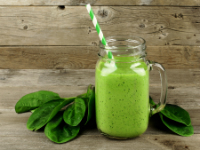AUGUST 2015
WHAT’S NEW
THE HEALTHIEST KIDS ON THE BLOCK

KEEP KIDS IN MOTION. Once kids return to school, they are sedentary for the better part of the day. Outside of school, make sure your kids have opportunities to stretch, strengthen, and build endurance for 60 minutes daily. Make time for creative play at the park where children can engage all the major muscle groups. Provide opportunities for trying new sports or creative movement classes. Get the whole family involved with obstacle courses, biking, or hiking. When the weather outside is frightful, visit an indoor pool, playscape, climbing gym, or bounce-house facility.
LIMIT SCREEN TIME. With more schools incorporating digital devices into curricula, it’s important to monitor your child’s free time on the screen. For younger children, set a daily limit of 60 minutes, and for older children, set a limit of 120 minutes for all media- TV, movies, and games.
Consider having a “digital-free zone” in your home: one room designated just for reading, games, and music sans the headphones. Also, make one day a week (e.g., Sunday) a “device-free day” for all family members. Play games or get physically active, together.
A BALANCED DIET, NOT A FOOD FIGHT. No matter their age, kids can be picky eaters. Offer your child choices at meals that are acceptable to you, health promoting, and palatable. Model the healthy eating habits you want your child to have whether they are at home or out with friends.
When it comes to getting kids to try new foods, get creative: Blend veggies into homemade smoothies. Serve raw veggies with hummus. Make zucchini-based brownies. Add fresh berries and dark chocolate nibs to a small serving of frozen yogurt. For the youngest kids, try renaming foods- steamed broccoli with cheese becomes “Hot-lava-covered trees.” Kids’ palates change as they age; what they like or don’t like at age 3 is likely to be different at 13 and even 23!
Introduce and reintroduce healthy selections at all meal and snack times. And don’t fight about food… that only creates a lousy mood for everyone at mealtimes. Sometimes, it really is okay to skip the asparagus and still have dessert.
TAME THE SWEET TOOTH. Sugar intake for children is recommended to 3-4 teaspoons a day. Cutting back on soda, candy, and cookies is only the first step. Read labels to identify added sugar that can be hidden in foods including bread, condiments such as ketchup, and canned and frozen foods. Make your own frozen treats from fresh fruit, and cut down on packaged foods.
SLEEP WELL. During sleep, children’s bodies generate hormones important to healthy growth and development. A good night of rest allows children to wake energized for the following day. Research has shown that sleep plays a role in maintaining a healthy weight and promoting a positive mood. Try to keep kids to a daily sleep-wake routine, especially during the school week.
REFERENCES
- Dudley, D., W. Cotton, and L. Peralta. “Teaching Approaches and Strategies That Promote Healthy Eating in Primary School Children: A Systematic Review and Meta-Analysis.” The International Journal of Behavioral Nutrition and Physical Activity 12 (2015): 28.
- FamilyDr. “School Lunches: Helping Your Child Make Healthy Choices.” Updated March 2015.
- HelpGuide. “Nutrition for Children and Teens.” Updated June 2015.
- KidsHealth.org. Site written for children to help them learn about a healthy lifestyle.
- Kondracki, N.L. “The Link Between Sleep and Weight Gain — Research Shows Poor Sleep Quality Raises Obesity and Chronic Disease Risk.” Today’s Dietitian 14, no. 6 (2012): 48.
- National Sleep Foundation. “Children and Sleep.” Accessed June 2015.
- Stevens, A., et al. “Do Sugar-Sweetened Beverages Cause Adverse Health Outcomes in Children? A Systematic Review Protocol.” Systematic Reviews 3 (2014): 96.
- Yale Health. “Be a Sugar Detective.” Accessed June 2015.
FOOD FOR THOUGHT. . .
“You can learn many things from children. How much patience you have, for instance.” – Franklin P. Jones
POWER OF JUICING

Juicing can provide a healthy quick fix for busy mornings or eating on the run. When it comes to kids, juicing can be a fun and tasty way to get them to eat foods they tend to push off the plate. For all ages, juicing is an alternative to taking a multivitamin, provided there is variety in your selection of fruits and vegetables. As always, try to use organic products.
JUICING TIPS
You can find many juicing recipes online and in books. Or, experiment with mixing up your own combinations of fruits and vegetables to suit your taste.
Many juicing recipes use only fruits and/or recommend adding additional forms of sugar- be it honey or agave. It may be best to first taste your juice for sweetness and avoid any extra sweeteners.
Many prepared juices and juice smoothies may contain more sugar and calories than you realize; these extra calories can contribute to weight gain. Read labels.
REFERENCES
- Mayo Clinic. “Is Juicing Healthier than Eating Whole Fruits or Vegetables?” January 2014.
- New Health Guide. “Benefits of Juicing.” Accessed June 2015.
- Van Straten, M. “Super Juice: Juicing for Health and Healing.” (Whitecap Books, 2003).
RECIPE: GREEN “SUPER HERO” JUICE

- 5 cups organic spinach
- 1 bunch organic kale (~8 stalks)
- 6 medium organic carrots
- 1 organic apples
- 1 organic lemon (peeled)
- 3 slices of organic golden honeydew (could substitute cantaloupe or pineapple chunks)
Rinse all produce, even if using organic items. Use a juicer to juice all the ingredients. Yields 42 oz.
PINK GLOW JUICE
The name might tickle little girls pink, but for boys, renaming this one Red Rocket Fuel is sure to get them fired up!
- 10 medium-sized organic oranges, segmented
- 8 medium-sized organic carrots, roughly chopped
- 1 medium-sized organic beetroot, roughly chopped
- 15 organic strawberries (seasonal)
- 1 cup crushed ice for serving
Combine all the ingredients together and juice. Place ¼ cup of ice in 4 individual glasses and pour equal quantities of the juice over it. Serve immediately.
REFERENCES
- Green Juice Recipe Source: Nosh and Nourish
- Pink Juice Recipe Source: Eat Well Stay Well
VITAMIN & MINERAL SUPPLEMENT TIPS FOR CHILDREN

Just like adults, children can benefit from vitamin and mineral supplements. However, children’s metabolism and their immune, digestive, and central nervous systems are still maturing, so the effects and side effects of supplements can differ from those seen in adults. This is especially true for infants and young children. When considering nutritional supplements for youngsters, it’s important to seek a trusted source to increase the likelihood that the product has been properly formulated, labeled, and has gone through quality assurance testing. Before giving your children supplements, seek a qualified health practitioner to evaluate your child and test for any vitamin and mineral deficiencies.
A BASIC SUPPLEMENT REGIMEN FOR CHILDREN INCLUDES
MULTIVITAMIN: Look for one derived from whole foods, or if that is not available, a standard formulation. Check labels to be sure the product is free from fillers, toxins, and added sugar.
MULTI-MINERAL: A good quality multi-mineral includes an array of trace minerals such as zinc, magnesium, and calcium.
OMEGA 3s: Look for omega-3 fish oil supplements that have been independently tested for heavy metals and PCB (a man-made manufacturing substance and known cancer-causing agent banned in 1979 that may still be present in some manufacturing processes).
PROBIOTICS: Ideally contain 10 billion, multi-strand organisms from a reputable source.
VITAMIN D: Current guidelines suggest 600 IU; test levels first.
Based on individual health needs, there may be times when a specific supplement regimen or higher amounts of a supplement may be needed- a decision best made with your holistic practitioner.
REFERENCES
- Gaby, A. Nutritional Medicine. Concord, N.H.: Fritz Perlberg Publishing: 2011.
- Natural Health Academy. “Vitamin Supplementation.” April 29, 2014.
- NIH National Center for Complementary and Alternative Medicine. “5 Things to Know About Safety of Dietary Supplements for Children and Teens.” Updated June 4, 2015.
- Skowron, J. M. Fundamentals of Naturopathic Pediatrics. Toronto: CCNM Press; 2009.
KID-SAFE HERBALS FOR HEALTH

Infusions, while prepared similarly to tea, do not contain leaves from the tea plant Camellia sinensis (e.g., black, white, and green tea). Infusions are prepared from the delicate leaves and flowers of herbs. A steeping process extracts the beneficial components of the herb: Place the plant parts in a jar and cover them with boiling water. Allow the liquid to sit for as long as you’d like, unless otherwise instructed. The longer the steeping process, the more potent the infusion will be. Infusions can be added to hot or iced beverages, and in cooking.
Herbal teas are made using water and are the easiest to prepare- but tend to be the least concentrated way of using herbs. You often have to drink larger quantities to achieve the same medicinal benefit than if you were using a tincture or infusion. But don’t discount its health benefits: An herbal tea is a real delight when you are nursing a cold. Check labels when buying packaged herbal teas- some will contain Camellia sinensis (the tea plant) and may contain caffeine.
A wide variety of recipes exist for herbal beverages. Follow herb preparation instructions carefully- especially boiling time and steeping time. Otherwise, the medicinal properties of the tea may be too strong or weak, bitter, or flavorless.
HERBAL BEVERAGES, HOT OR ICED, CHILDREN MAY ENJOY
Fall: Astragalus, black elderberry, raw honey (immunity booster, cold remedy)
Winter: Ginger, cinnamon, lemon balm, hibiscus, raw honey (warming, good for colds)
Spring: Stinging nettles, rosehips, milky oat seed, raw honey (allergen fighter, especially at change of seasons)
Summer: Chamomile, lemon balm, rose hips, raw honey (calming, cooling)
REFERENCES
- American Herb Society. “Great Herbs for Kids.” (PDF)
- McBride, K. The Herbal Kitchen: 50 Easy-to-Find Herbs and Over 250 Recipes to Bring Lasting Health to You and Your Family. Red Wheel/Weiser, LLC: 2010.
- Nourishing Herbalist. “The Difference Between Tinctures, Tonics, and Teas…Oh My!” Blog post. July 23, 2013.
- Patton, C. “Herbal Remedies for Kids — Evidence Shows Nature’s Medicines Can Relieve Common Childhood Illnesses.” Today’s Dietitian 15, no. 2: 13.
IT’S TIME TO PLAY!

TREASURE HUNT. Create a themed scavenger hunt around your house or at a local playground. Try Letterboxing, which involves parks, hiking trails, and treasure!
ULTIMATE PLAYGROUND CHALLENGE. Number the stations at a local playground and have kids try to finish the stations in their personal best time. Older kids might want to compete against each other or a parent.
GREAT OUTDOORS. State parks offer hiking/biking trails, fishing, kayaking, canoeing (rent or bring your own), and guided nature talks. Also, try gardening or help clean up a local park.
BOARD GAMES. From Jenga to Twister to Clue, board games and role-playing games are great for families. Make this a community service outing by visiting an assisted living center to play games with residents who often don’t have family of their own to visit them.
GET CRAFTY. Build with Legos or blocks. Scrapbook. Visit a make-your-own pottery store. Check class schedules at your local craft store.
NO SCOREKEEPER. Play for the fun of it! Don’t keep score- or choose activities that don’t require a scorecard: kite flying, Frisbee/Frisbee golf, dancing, hide-and-seek, yoga.
REFERENCES
- American Heart Association. “Activities for Kids & Families.”
- Kids Health. “It’s Time to Play.”
- Ginsburg, K. R., et al. “The Importance of Play in Promoting Healthy Child Development and Maintaining Strong Parent-Child Bonds.” Pediatrics 119, no. 1 (January 1, 2007): 182 -191.
- Institute of Play.
- Isenberg, J.P., and M.R. Jalongo. “Why is Play Important? Social and Emotional Development, Physical Development, Creative Development.” Excerpt from Creative Thinking and Arts-Based Learning Preschool Through Fourth Grade (Merrill, 2006 edition, p. 53-55).
GUIDING PRINCIPLES

First Do not Harm

Identify and Treat the cause

Healing Power of Nature

Doctor as Teachers

Treat the Whole

Prevention is best Medicine
Follow us on instagram
BLOG
Become an educated consumer with our Indigo Blogs and prevent dis-ease.
Our Doctors have been featured in:









